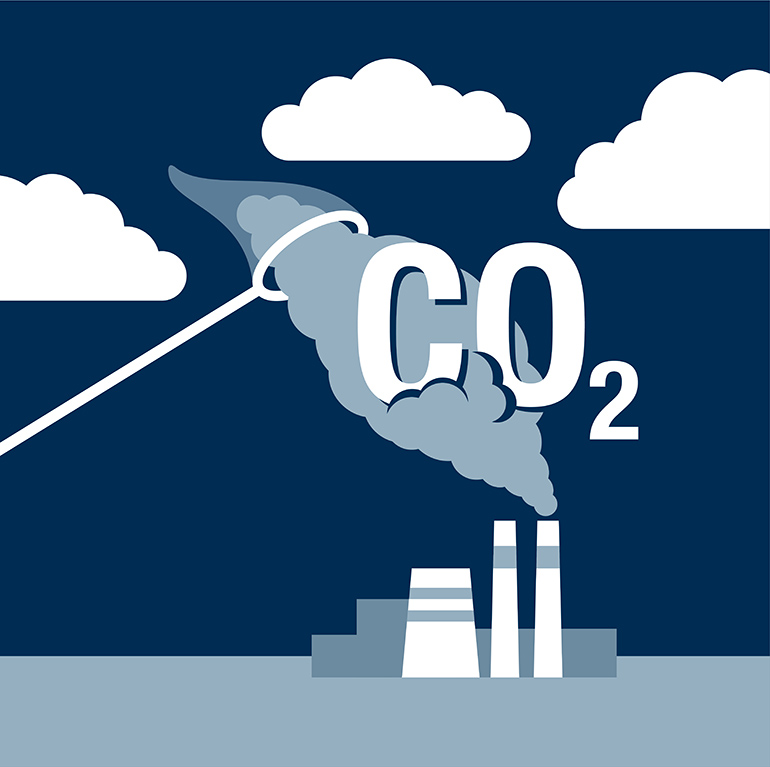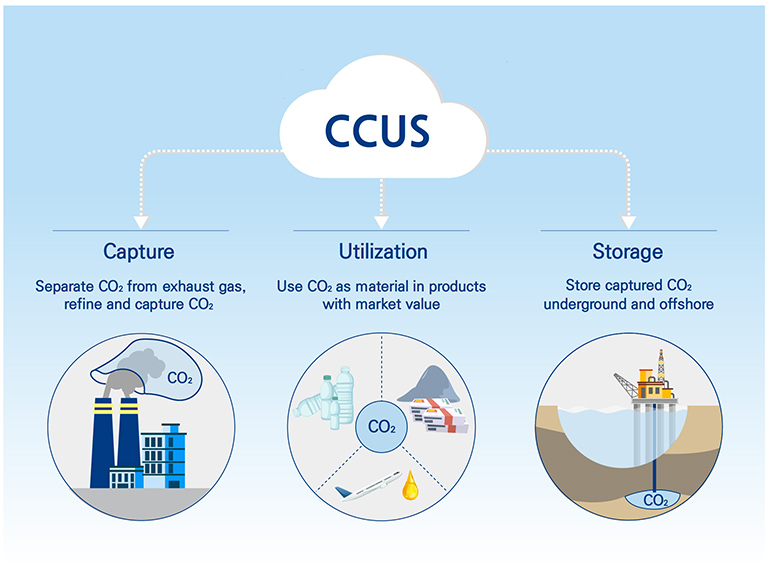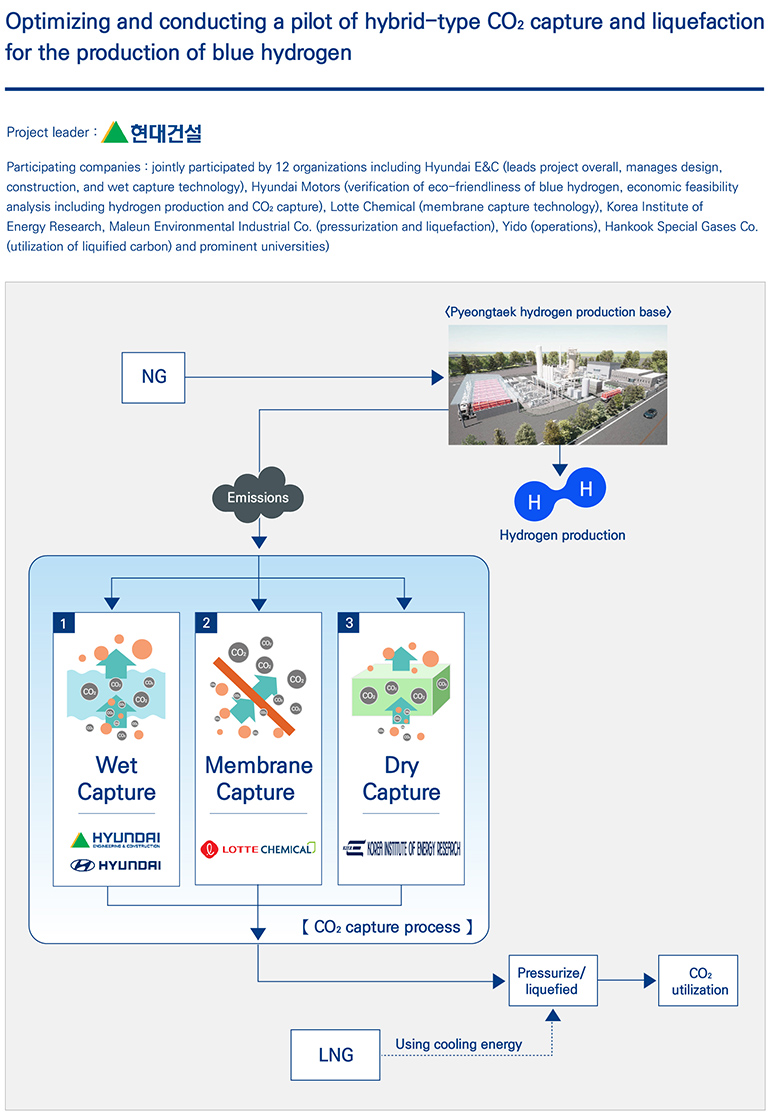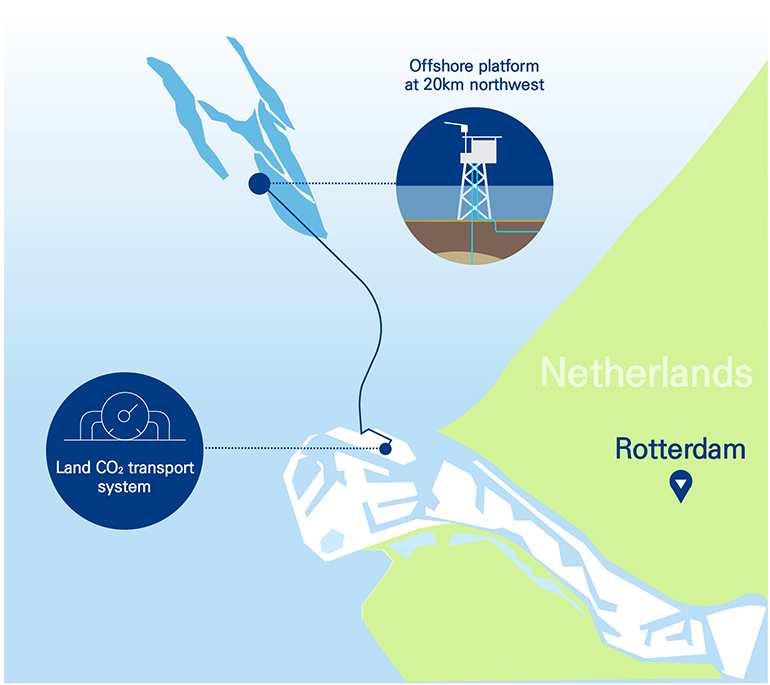
Latest News
- Hyundai E&C Accelerates Global Nuclear Expansion into the U.S. Nuclear Market
- Hyundai E&C Shifts into High Gear to Enter Nordic Large-Scale Nuclear Market
- Hyundai E&C Strengthens Korea-Japan Cooperation in Energy Transition and New Growth Businesses
- Hyundai E&C Signals Green Light for Large-Scale Nuclear Power Plant Business in Europe
- Hyundai E&C Unveils Energy-driven Growth Strategy “H-Road”
[Hyundai E&C’s Carbon Neutrality Technology #2] Developing the Strongest Weapon in Protecting the Planet? Hyundai E&C’s CCUS Technology

[ If we cannot avoid CO₂ emission completely, then it is important to capture and store or effectively utilize emitted carbon. That is why CCUS technology is rising as a realistic solution for carbon neutrality. ⓒGetty Images Korea ]
The ‘war on carbon’ has begun. The battle is between the main culprit in global warming, or carbon, versus humanity. Countries worldwide have declared to achieve ‘net-zero’ to restrict Earth’s temperature increase, which is getting warmer every day, to less than 1.5 degrees by 2050. Net-zero means emitting zero carbon beyond simply reducing greenhouse gas emissions or capturing carbon to make emissions equal ‘zero.’ However, CO₂ is emitted almost inevitably as we live our lives. Factories make products and carbon is created in every step of the process in generating the energy that we use. That’s why cutting carbon emissions to ‘zero (0)’ seems almost like a fantasy. Many experts explain that it is important to process carbon emissions until the day when we can completely halt the use of fossil fuel. In other words, if we cannot avoid carbon emissions completely, then it is important to capture and store or effectively utilize emitted carbon. This is the background to how Carbon Capture Utilization and Storage (CCUS) rose as one of the most realistic solutions in achieving carbon neutrality.
An Essential Technology in Producing Blue Hydrogen… Achieving the Dream of Carbon Neutrality with CCUS
CCUS refers to an array of technologies that ‘capture’ carbon emissions released in the process of burning or processing fossil fuel such as during thermal power generation, by the steel industry, cement industry, or the petrochemical industry, to ‘utilize’ or ‘store’ them. The technology can be categorized into CCU, if it enables utilizing captured carbon, or CCS if it is about storing captured carbon. Many credible international organizations also turn to CCUS as the priority technology in achieving net zero. The *International Energy Agency (IEA) declares that we cannot achieve net zero without CCUS and emphasizes that we must resolve 15% of the cumulative reduction in global emissions with this technology.
*An international energy planning organization under OECD that was established with the mandate of ensuring energy security and energy policy collaboration.

[ CCUS refers to an array of technologies that ‘capture’ carbon emissions to ‘utilize’ or ‘store’ them. Utilizing captured carbon is called CCU, while storing it is called CCS. ]
CCUS technology is also inevitable in achieving ‘hydrogen economy.’ The paradigm shift in energy towards hydrogen began with a consensus on preventing further global warming by reducing greenhouse gas emissions. That’s why we ultimately pursue *green hydrogen that doesn’t emit carbon dioxide. However, there aren’t a lot of infrastructure for green hydrogen production around the world and it will take time and effort to ensure its economic feasibility. Therefore, the most realistic solution in a situation where we cannot completely remove fossil fuel from the equation is ‘blue hydrogen.’ Blue hydrogen is produced in the same way as producing *grey hydrogen which releases CO₂. The difference is whether CO₂ is released by introducing CCUS technology in the process.
*Green hydrogen is produced by splitting water using electricity generated from renewable energy.
*Producing 1kg of grey hydrogen from natural gas emits around 10kg of carbon dioxide.
Experts predict that by 2050, blue hydrogen will account for 24% of the global hydrogen demand. They say that the amount of CO₂ capture and blue hydrogen production will increase especially in countries like the U.S., the EU, and the Middle East where they have huge amount of fossil energy or a rich environment to supply bioenergy. In fact, these countries are actively pursuing large-scale CCUS pilot projects with some of the technologies already entering commercialization stage.
Korea declared carbon neutrality in December 2020 and announced its ‘1st Hydrogen Economy Master Plan’ in November the following year. The plan sets out to increase the country’s self-sufficiency rate of *clean hydrogen to 34% by 2030 and up to 60% by 2050 to achieve a transition from carbon-based society into a hydrogen society. The government also announced it will pursue to commercialize CCUS early on in producing blue hydrogen and that it will identify potential carbon storages at home and abroad. In line with the government’s carbon neutrality policy, Hyundai E&C has also made efforts as the leading construction company of Korea. The company is especially making effort to preemptively secure CCUS technology, which is essential in blue hydrogen production, to accelerate the country’s journey in achieving net zero.
*Clean hydrogen: hydrogen that emits significantly low levels of CO₂ or almost zero CO₂ in the process of production, including both green hydrogen and blue hydrogen.
CCUS Securing World-class ‘Carbon Capture’ Technology as a Leader of National Project
Hyundai E&C is conducting a national project of the Ministry of Science and ICT with 12 other companies and organizations including Hyundai Motors, Lotte Chemical, and Korea Institute of Energy Research since May 24. The project is about ‘optimizing and conducting a pilot of hybrid-type CO₂ capture and liquefaction for the production of blue hydrogen,’ which is being implemented at the recently established hydrogen production base (phase 1) in Pyeongtaek. The phase 1 facility produces up to 7 tons of hydrogen a day (aiming to produce up to 39 tons in the future). The facility that will be used to implement the national project is located between the hydrogen production plants of Korea Gas Corporation and Korea Gas Technology Corporation within the base. Participating companies and organizations will be capturing a daily average of more than 100 tons of CO₂ with 90% recovery and more than 95% purity for 33 months using a *low energy method.
*Low energy method refers to cutting power consumption significantly. Captured CO₂ is liquified (liquified carbon) to make it easy to store and transport. Liquified carbon is made by pressurizing and freezing room-temperature carbon, which requires a significant amount of energy. Hyundai E&C’s research team plans to liquify carbon using the cool thermal energy (cooling energy, minus 162 degrees) of an LNG facility located near the capturing facility. This will save electricity tremendously.
As the leading company overseeing the project, Hyundai E&C is responsible for not only the design, construction, and operation of the entire facility’s system, but also in securing a world-class carbon capture technology. A CCUS expert with the company said, “we plan to develop a design for a carbon capture and liquefaction plant of 1 million tons a year after conducting the pilot project on site” and declared with ambition saying, “we will be able to secure the ability to design ‘CCU FEED (Front End Engineering Design)’ of the largest scale in the world.”

[ Infographics summarizing the roles in the national project. As project leader, Hyundai E&C is in charge of the design, construction, and operation of the entire facility system as well as securing world-class technology through pilot research on three types of capture technologies. ]
Carbon capture is key in CCUS technology. That is because you can only store or utilize CO₂ once you’ve captured it first. There are several ways in carbon capture: ‘wet-type capture’ that absorbs CO₂ using liquid absorbent, ‘dry-type capture (or VSA capturing)’ that uses solid absorbent, and ‘membrane capturing’ that splits the gas by making it pass through *hollow fiber membrane. The national project takes on a hybrid form, applying all three capturing technologies. It is the country’s first-ever commercialization-grade pilot facility.
*Hollow fiber membrane takes on a cylinder structure of a microscopic size with a hollow center.
Classification | wet capture | dry capture (VSA capture) | membrane capture |
Technology summary | · absorbs using liquid absorbent | · absorbs using solid absorbent | · split passing hollow fiber membrane |
Advantages | · high technology maturity · can process large amounts of gas | · simple device · favorable for processing small to mid-scale gas | · simple device, easy to operate · can be modularized |
Disadvantages | · must regularly supplement absorbent · possible corrosion | · difficult to process gas in large amounts · high desorption energy | · difficult to process gas in large amounts · less separation factors between gases · high energy consumption when pressurizing gas |
Size (application) | large (power plants, large-scale industrial boilers) | medium (industrial boilers) | small (small applications) |
[ Comparison of carbon capture technologies ]
Hyundai E&C is piloting the wet capture technology that enables large-scale gas processing out of the three types of technologies. Wet capturing uses ‘KIERSOL,’ a liquid absorbent of CO₂ developed by using only Korean-made technology by Korea Institute of Energy Research. KIERSOL is a type of material technology that selectively absorbs and captures CO₂ from combustion exhaust gas. It is patented in 7 countries around the world. Through a MOU with Hyundai Motors in February, Hyundai E&C now owns a KIERSOL license (allowed to apply in all areas related to natural gas). The company aims to leverage its strategy to enhance CCUS competitiveness by using this technology, which has outstanding performance over other advanced companies and allows for an economically feasible operation.
CCUS International Joint Research with Globally Leading Country… Will it Positively Impact in Winning the East Sea Gas Field Project
Now, once you’ve captured CO₂, the next step is ‘storing’ and ‘using’ it. As an EPC company, Hyundai E&C is dedicated to storing CO₂ in depleted reservoirs (underground reservoirs that have previously produced oil or natural gas). Since May, the company is conducting international joint research with the Netherlands under the leadership of *K-CCUS to secure CCS technology. The Netherlands is the first country in the world to successfully store CO₂ in an offshore depleted gas field. Many CCS projects are implemented across the country including the Port of Rotterdam CO₂ Transport Hub and Offshore Storage (PORTHOS) that transports and stores captured CO₂ from the Port of Rotterdam industrial complex to empty gas fields beneath the North Sea using underground pipelines for the production of blue hydrogen. Hyundai E&C, in partnership with K-CCUS, is studying the ‘CCS optimal storage design and facility conversion technology’ using the depleted gas fields of the Netherlands. It is especially in charge of developing CCS facility conversion technology.
*Established under the Ministry of Trade, Industry, and Energy, K-CCUS is a public-private partnership organization with some 80 research institutes, private companies, and public corporations as members.

[ The Netherlands is the first country in the world to successfully store CO₂ in an offshore depleted gas field. Hyundai E&C, under the leadership of K-CCUS, is studying ‘CCS optimal storage design and facility conversion technology’ using the depleted gas fields of the Netherlands. The photo is a location map of PORTHOS that transports CO₂ captured at the Port of Rotterdam industrial complex to the empty gas fields of the North Sea using underground offshore pipelines for the production of blue hydrogen. ]
The reason why Korea takes an interest in CCS projects is the East Sea gas fields. At the end of last year, the gas fields of the East Sea off the shore of Ulsan, which placed Korea as the 95th largest oil-producing country in the world, were completely depleted. The government therefore planned a CCS pilot project to store CO₂ in the depleted fields of the East Sea and set out to join hands with the Netherlands for technology cooperation to secure key technologies. An official at Hyundai E&C explained, “we were able to secure technology to convert and design a gas production and transport facility into a CCS facility by establishing a partnership with a technology leading country.”
Now, the remaining question is “how to make CO₂ a resource.” Carbon dioxide can be converted into and used in liquid or solid form. One main example is carbonated drinks. When carbon dioxide is dissolved in water, it turns into carbonated drink, which is why the drinks are fizzy. Liquified carbon dioxide is not only used in food and beverage, but also in ship building, manufacturing of vehicles, and welding in construction sites. Dry ice is also made with carbon dioxide. It is a form of freezing CO₂ gas and is also called solid carbon dioxide. There are other ways to make CO₂ into practical materials with potential market value. You can make chemical products such as fuel, fertilizer, or plastic using carbon as material. You can even use CO₂ in making consumer products like vodka or shoes, or as construction materials such as cement. Considering the possibilities, it may seem as if there is no need to store CO₂, because you can simply utilize all captured CO₂. However, this is easier said than done. That is because making CO₂ into a resource is much more expensive than the profits gained from selling the products. The International Energy Agency estimates that globally only 10% of captured CO₂ is processed as CCU, while CCS accounts for 90%. This is also the reason why many experts explain that lowering the cost in converting CO₂ is key in CCU technology.

[ The fizzy taste we enjoy when we drink carbonated soda comes from liquified CO₂. ⓒGetty Images Korea ]
Of course, Hyundai E&C is dedicated to conducting further CCU research. Hyundai E&C works closely with relevant organizations to use captured CO₂ as liquified carbon, industrial high-purity special gases, or in the production of chemical products through the national project of the Ministry of Science and ICT conducted at the Pyeongtaek hydrogen production site. In addition, the company plans to begin a CCU project that utilizes CO₂ emitted from the incineration plants of Osan, Gyeonggi-do and Jeonju, Jeonbuk and utilizing CO₂ as liquefied carbon starting September.
In the war on carbon dioxide, CCUS technology is currently the strongest weapon we have. Hyundai E&C is actively cooperating with specialized companies at home and abroad to gain advantage and competitiveness in the global CCUS market, which is predicted to reach USD 2 trillion by 2050. The Carbon Neutrality Research Team at Hyundai E&C’s Institute of Technology, which conducts research on the best solutions to reducing CO₂, explains, “we are enhancing our competitiveness in winning projects by ensuring world class level CCUS technology” and showed strong confidence by saying, “Hyundai E&C will change the game in the field of CCUS.”
Mini Interview | Carbon Neutrality Research Team in Technology Research Center
“Global agenda of net zero… we will reach the goal with CCUS technology”

Q What are the roles and responsibilities of the Carbon Neutrality Research Team at Hyundai E&C’s Institute of Technology?
Carbon Neutrality Research Team is dedicated to ensuring the core technologies of the CCUS value chain from capturing to storing and utilizing CO₂2. The team was established in May 23 to strengthen the company’s competitiveness in winning global projects related to carbon neutrality.
Q Hyundai E&C is committed to strengthening capability to become a game changer in the field of CCUS. Could you please elaborate per value chain?
▶In the area of CO₂ capturing (CC), our goal is to further advance our wet capture technology into commercialization level. We are designing a wet-type capture facility that separates and captures CO₂ from gases generated at hydrogen production facilities and waste incineration plants. In addition, we are conducting research in partnership with specialized research institutes on wet-type capture technology for combined cycle power plants. We are focusing our capability because it is an area that is expected to have high technology demand. ▶In the area of storage (CCS), we are developing a technology that injects captured carbon into a safe place after transport. The CO₂ transport and injection technology that we developed will be applied in future national projects including the ‘mid-size CCS pilot project in the East Sea gas fields (storing 400,000 tons of CO₂ annually)’ and the ‘large-scale CCS pilot project in Gunsan Basin (storing 1 million tons of CO₂ annually).’ ▶And lastly, in the area of utilization (CCU), we are focusing our efforts in developing technologies that can be commercialized in the near future. We are especially conducting R&D on processes to produce synthetic gases that are used as materials in key chemical products like ammonia or methanol.
Q What is the future of CCUS that Carbon Neutrality Research Team envisions?
To achieve the goal of ‘net zero by 2050’ pursued by the international community, we must make effort to reduce CO₂ emissions by enhancing the efficiency of existing facilities or expanding the use of new and renewable energy sources. We must also, at the same time, capture CO₂ emitted from fossil fuel powered facilities to store and use it. Without CCUS technology, we cannot achieve net zero. Unless we get rid of fossil fuel entirely, CCUS market will continue to grow. Hyundai E&C is committed to fulfilling its role as a ‘technology leader’ in the CCUS plant market at home and abroad.

